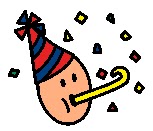Happy New Year! January is an exciting time to change things up and try something new. In our daily conversations we greet people, ask questions, comment, describe and that's all before a cup of coffee! Many kids who use AAC are great at making requests but there is so much more to say! In this issue, we will explore ways we can get our students talking about anything.
Communicating, not just responding…All too often, and with all good intention, we provide many prompts to steer our kids in the right direction. “It’s your turn to ask a question. Find your question words. Push the button and tell us what your question is.” Sometimes our students learn to wait for these prompts, before using their vocabulary.
Communicating, not just responding…All too often, and with all good intention, we provide many prompts to steer our kids in the right direction. “It’s your turn to ask a question. Find your question words. Push the button and tell us what your question is.” Sometimes our students learn to wait for these prompts, before using their vocabulary.
Think about some fun ways to allow your students to experience using their words for different reasons. This will encourage your child to naturally use these language functions. For example, bring items for an activity in a bag and tempt the students to ask “what?”. Have a “special guest” come to the classroom, hiding behind a mask to encourage “who?”. The mask could have the corresponding “who” symbol right on the front, to remind students which symbol they are looking for.
 Puppets are great props for encouraging kids to talk, and allow you to act as facilitator. If your puppet keeps falling asleep, you need to get his attention. If your puppet has a secret in a box, you can ask him what it is. You can comment on how your puppet is feeling.
Puppets are great props for encouraging kids to talk, and allow you to act as facilitator. If your puppet keeps falling asleep, you need to get his attention. If your puppet has a secret in a box, you can ask him what it is. You can comment on how your puppet is feeling.
Add symbol labels into the environment, to further develop your child’s understanding of how these symbols can be used – not just labels, but language to show how those symbols can be used: “go out” on the door, “put in” on the drawer, “talk to me” on the phone.
Communication Functions:
There are a variety of reasons why and how we communicate. Encourage your student to expand their communication by modelling the use of symbols for them in context. You can do this by using their existing vocabulary on a device or using low tech. If your student has a core words page, this is an excellent place to show them how to use core to say so many things.
Review your child's core word page and see how they could communicate beyond choice making.
| Communication functions |
Ways to say it with core words
|
Turn Taking
|
"I + go", "you + go"
|
Calling Attention
|
"look + it"
|
Refusing
|
"not + want", "all done"
|
Greeting
|
"I + see+ you"
|
Asking a Question
|
"What"
|
Commenting
|
"I + like + it", "I + not+ like +it"
|
Directing Action
|
"again", "get + it"
|
Clarifying
|
"again?"
|
Responding to Questions
|
"more", "all done"
|
Describing
|
"big", "little"
|
Pretend
|
"you eat"
|
Express Emotion
|
"good+ good", "bad", "like" "not + like"
|
"Okey Dokey Artichokey!"
Kids may also enjoy using phrases commonly used by others. Ask peers what words or phrases they would use for different communication functions such as greetings, clarifying, calling attention, asking questions etc. Be sure to check with the child who is using AC, that they would like to use this type of vocabulary. Review the vocabulary as kids grow, they may want to change the way they are saying something.
Here is a list of suggested phrases from Linda Burkhart and Caroline Ramsey Musselwhite
Kids may also enjoy using phrases commonly used by others. Ask peers what words or phrases they would use for different communication functions such as greetings, clarifying, calling attention, asking questions etc. Be sure to check with the child who is using AC, that they would like to use this type of vocabulary. Review the vocabulary as kids grow, they may want to change the way they are saying something.
Here is a list of suggested phrases from Linda Burkhart and Caroline Ramsey Musselwhite





No comments:
Post a Comment